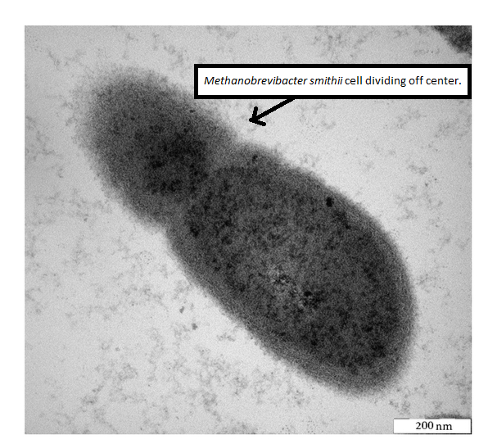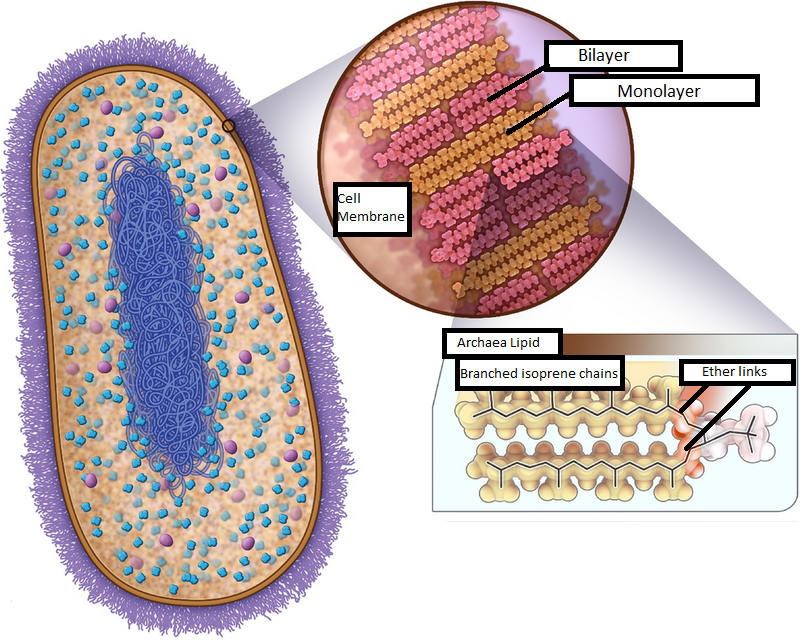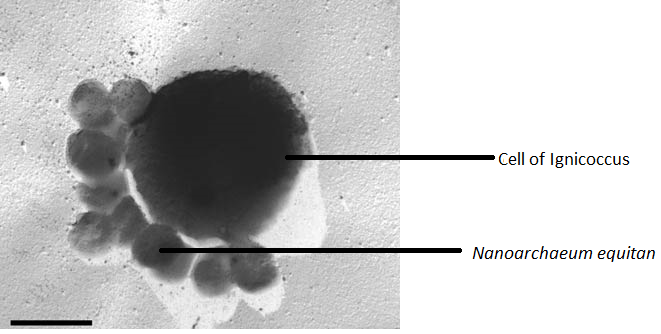Domain • One
•archaea•
Common name- Methanobrevibacter, smithii
Domain: Archaea
Phylum: Euryarchaeota
Class: Methanobacteria
Order: Methanobacterials
Family: Methanobacteriaceae
Genus: Methanobrvibacter
Species: smithii

Figure 1b: Methanobrevibacter, smithii dividing.
The image above shows the Methanobrevibacter smithii cell dividing off center. However, this is not the case in all of these cells. Some cells divide in the center, and some divide in irregular positions.

Figure 2b: Methanobrevibacter smithii
Image of cell wall and cell membrane of Methanobrevibacter smithii.
Methanobrevibacter smithii is a prokaryotic single-celled microorganism found in the gut of a human. This organism is an autotroph, meaning that it creates its own nutrition from its surroundings. It gets its nutrition from inorganic compounds and through a process known as carbon fixation. In addition, this organism uses inorganic compounds and photophosphorylation in order to receive its energy. There is no nervous system within this microorganism and it is motile via flagella and cilia. Methanobrevibacter smithii reproduces asexually by binary fission, budding, and fragmentation [1b]. Species in this domain can usually be found in places with hot temperatures, acidic and anaerobic environments [2b]. The human gut is an ideal environment because it is acidic. The acidic environment in which this organism lives comes from the digestive system of the human releasing acid in order to break down food. In addition, the gut is a very warm place, as the body’s internal temperature is approximately 37° C. This microorganism is part of the human immune system and can cause an inflammatory cytokine response. An inflammatory cytokine response is when inflammation causes molecules to signal the cells telling them that there is an infection. This means that it participates in the body’s response to infections, inflammation, cancer, and reproduction [3b]. Methanobrevibacter smithii is approximately 0.63 millimeters in length and oblong in shape [4b].
Why this belongs in this Domain:
This microorganism belongs in this domain for many reasons. Methanobrevibacter, smithii has a cell wall composed of pseudomurein rather than murein. Since this organism lives in less than ideal environments for humans, it is put into the domain Archaea. It is a methanogen, which means it produces methane and is usually found in intestines. This places it in the phylum Euryarchaeota. It belongs in the species of smithii because it removes hydrogen and lives in the human gut. No other species does this. Methanobrevibacter, smithii does not belong in domain Bacteria because its cell wall does not contain peptidoglycan and because the first amino acid for protein synthesis in Bacteria is Formylmethionine while in Archaea it is Methionine. Also, Methanobrevibacter, smithii does not belong in domain Eukarya because it does not have a nuclear envelope and the organisms in Archaea are prokaryotic and not eukaryotic.
Common name- Nanoarchaeum equitans
Domain: Archaea
Phylum: Nanoarchaeota
Class: none
Order: none
Family: none
Genus: Nanoarchaeum
Species: equitans

Figure 3b: Nanoarchaeum equitans
Cell of Ignicoccus with cells of Nanoarchaeum equitans attached to its surface. Electron micrograph.
Nanoarchaeum equitans is a prokaryotic single-celled microorganism that was discovered in 2002. It was found in a hydrothermal vent, which is one common place for an organism in this domain to be found. A hydrothermal vent is hot and contains acidic sea water . This microorganism is one of the smallest known cellular organisms and smallest known Archaeon, with its cells measuring 400 nanometers in diameter. Almost all of the genes required for the synthesis of amino acids, nucleotides, and lipids are absent in this organism. Therefore, it most likely obtains these molecules from an organism called Ignicoccus [5b]. Along with the Methanobrevibacter, smithii, this organism is an autotroph meaning that it creates its own nutrition from its surroundings. It gets its nutrition by using carbon fixation and inorganic compounds. In addition, in order for the organism to receive its energy it uses organic compounds and photophosphorylation. There is no nervous system within these microorganisms and they get around using flagella and cilia. They reproduce asexually by binary fission, budding, or fragmentation [1b].
Why this belongs in this Domain:
Nanoarchaeum equitans belongs in domain Archaea for a few reasons. It contains no nucleus and lacks membrane bound organelles. It contains a single circular chromosome. This organism is the only organism in its phylum, Nanoarchaeota. It does not belong in domain Eukarya because all of the organisms in that domain are multicellular and eukaryotic while this organism has prokaryotic cells and is unicellular. Although domain Archaea and domain Bacteria are similar, domain Bacteria cannot live in extreme environments.
Answer the following questions based on the paragraphs above.
RJ